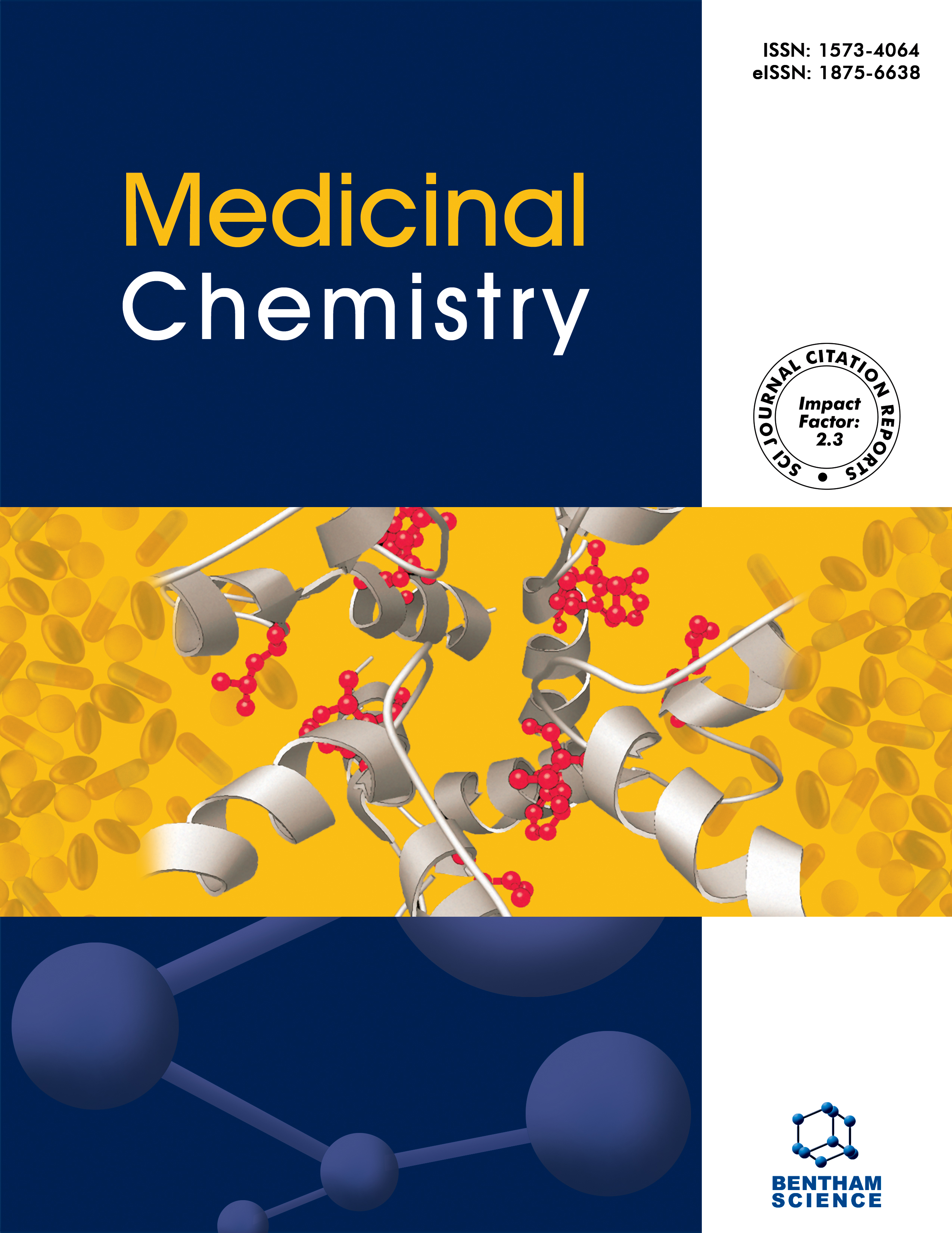- Home
- A-Z Publications
- Medicinal Chemistry
- Previous Issues
- Volume 10, Issue 3, 2014
Medicinal Chemistry - Volume 10, Issue 3, 2014
Volume 10, Issue 3, 2014
-
-
Chemistry, Stability and Bioavailability of Resveratrol
More LessAuthors: Antonio Francioso, Paola Mastromarino, Alessandra Masci, Maria d’Erme and Luciana MoscaResveratrol is a bioactive polyphenol found in many vegetables. It is well known for its multiple pharmacological activities, such as anti-inflammatory, antioxidant, antimicrobial, anticancer, neuroprotective and cardioprotective effects. In vitro evidence of resveratrol efficacy is widespread, however, many concerns regarding its effectiveness in vivo arise from its poor stability in vitro and bioavailability following Read More
-
-
-
Mevalonolactone: An Inhibitor of Staphylococcus Epidermidis Adherence and Biofilm Formation
More LessStaphylococcus epidermidis, a commensal microorganism at the human skin and mucosae, is nowadays considered an important opportunistic pathogen related to nosocomial infections on indwelling medical devices due biofilm formation. Bacterial biofilms are the worst aspect in the treatment of infections and now efforts have been made in the search for new molecular entities to overcome this situation. In this work Read More
-
-
-
Inhibitory Activity Against Epidermal Growth Factor Receptor (EGFR) Based on Single Point Mutations of Active Site Residues
More LessEpidermal growth factor receptors belong to the ErbB family of receptor tyrosine kinases (TKs) involved in the proliferation of normal and malignant cells. EGFR has attracted considerable attention as a target for cancer therapy. The findings reported herein are believed to provide some novel insights into the design of effective drugs for the therapeutic treatment of EGFR-related cancers. In particular, it is shown usi Read More
-
-
-
Antibacterial Activity of Thioetherhydroxyethylsulfonamide Derivatives
More LessThioetherhydroxyethylsulfonamide derivatives were synthesized and evaluated for their in vitro antibacterial activity against Escherichia coli (ATCC 25922), Pseudomonas aeruginosa (ATCC 27853) and Staphylococcus aureus (ATCC 25923). Results have shown that compounds 8c and 9e display potent activity (MIC = 0.125 µg/mL) against E. coli when compared with the standard drug sulfamethoxazole (SMZ, MIC < 0.5 µg/mL) for Read More
-
-
-
Structural Analysis for Colchicine Binding Site-Targeted ATCAA Derivatives as Melanoma Antagonists
More LessAuthors: Jiawei Zhang, Feng Li, Yan Li, Yangyang Guo, Jinghui Wang and Shuwei ZhangMelanoma is the fatal form of skin cancer. Herein, a three-dimensional quantitative structure-activity relationship study on a series of 105 colchicine binding site-targeted 2-arylthiazolidine-4-carboxylic acid amides (ATCAA) derivatives as melanoma antagonists was conducted. The optimal CoMSIA model yields a Q2 of 0.556, R2ncv of 0.833 and R2pred of 0.757, while the CoMFA yields a Q2 of 0.569, R2ncv of 0.812 Read More
-
-
-
Synthesis, Immunomodulation and Cytotoxic Effects of Vanadium (IV) Complexes
More LessVanadium is known to exhibit several bioactivities and shows potential as a pharmaceutical drug. The current studies were conducted with the goal of synthesizing a new generation of oxovanadium(IV) complexes, investigating their effects on cancer cell proliferation and their immunomodulatory properties, and predicting possible structure activity relationships. The elucidation of the structures of the synthesiz Read More
-
-
-
Synthesis and Biological Activities of 2,6-Dihydroxy-4-Isopentenyloxychalcone as an Antimicrobial and Anti-Inflammatory Compound
More LessChalcones are a group of plant-derived polyphenolic compounds possessing a wide variety of biological activities. The aim of this study was to synthesize 2,6-dihydroxy-4-isopentenyloxychalcone (1), a chalcone found in plants belonging to the genera Helichrysum, Pleiotaxix and Metalasia, and evaluate its antimicrobial effects against major oral pathogens as well as its anti-inflammatory properties. Compound 1 was synthes Read More
-
-
-
Discovery of 6-Deoxydapagliflozin as a Highly Potent Sodium-dependent Glucose Cotransporter 2 (SGLT2) Inhibitor for the Treatment of Type 2 Diabetes
More LessAuthors: Lingyu Zhang, Yuli Wang, Huaqiang Xu, Yongheng Shi, Bingni Liu, Qunchao Wei, Weiren Xu, Lida Tang, Jianwu Wang and Guilong ZhaoSystematic mono-deoxylation of the four hydroxyl groups in the glucose moiety in dapagliflozin led to the discovery of 6-deoxydapagliflozin 1 as a more active sodium-dependent glucose cotransporter 2 (SGLT2) inhibitor (IC50 = 0.67 nM against human SGLT2 (hSGLT2) vs 1.16 nM for dapagliflozin). It exhibited more potent blood glucose inhibitory activity in rat oral glucose tolerance test and induced more urinary gluco Read More
-
-
-
Design, Synthesis and Biological Screening of Some Pyridinylpyrazole and Pyridinylisoxazole Derivatives as Potential Anti-inflammatory, Analgesic, Antipyretic and Antimicrobial Agents
More LessA series of substituted pyridinylpyrazole (or isoxazole) derivatives were synthesized and evaluated for their anti-inflammatory (AI) activity using formalin-induced paw edema bioassays. Their inhibitory activities of cyclooxygenase-1 and cyclooxygenase-2 (COX-1 and COX-2) were also determined. The analgesic activity of the same compounds was evaluated using rat-tail withdrawal technique. Their antipyretic activity Read More
-
Volumes & issues
-
Volume 21 (2025)
-
Volume 20 (2024)
-
Volume 19 (2023)
-
Volume 18 (2022)
-
Volume 17 (2021)
-
Volume 16 (2020)
-
Volume 15 (2019)
-
Volume 14 (2018)
-
Volume 13 (2017)
-
Volume 12 (2016)
-
Volume 11 (2015)
-
Volume 10 (2014)
-
Volume 9 (2013)
-
Volume 8 (2012)
-
Volume 7 (2011)
-
Volume 6 (2010)
-
Volume 5 (2009)
-
Volume 4 (2008)
-
Volume 3 (2007)
-
Volume 2 (2006)
-
Volume 1 (2005)
Most Read This Month
Article
content/journals/mc
Journal
10
5
false
en


